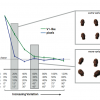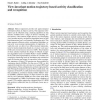116 search results - page 16 / 24 » Towards using multiple cues for robust object recognition |
CVPR
2009
IEEE
15 years 2 months ago
2009
IEEE
In recent years, large databases of natural images have
become increasingly popular in the evaluation of face and
object recognition algorithms. However, Pinto et al. previously
...
MMS
2006
13 years 7 months ago
2006
Motion trajectories provide rich spatio-temporal information about an object's activity. The trajectory information can be obtained using a tracking algorithm on data streams ...
BMVC
2001
13 years 10 months ago
2001
This paper addresses the problem of using appearance and motion models in classifying and tracking objects when detailed information of the object’s appearance is not available....
ICMCS
2005
IEEE
14 years 1 months ago
2005
IEEE
We present a novel human posture recognition method using convex programming based matching schemes. Instead of trying to segment the object from the background, we develop a nove...
HRI
2006
ACM
14 years 1 months ago
2006
ACM
The essence of the signal-to-symbol problem consists of associating a symbolic description of an object (e.g., a chair) to a signal (e.g., an image) that captures the real object....


